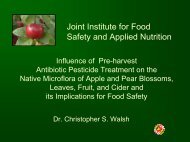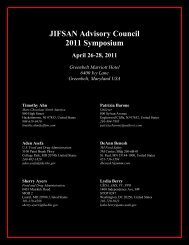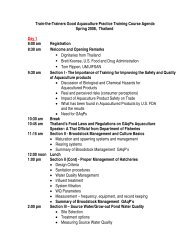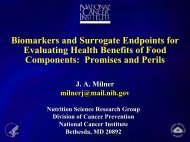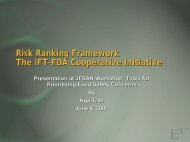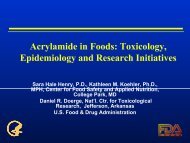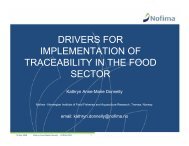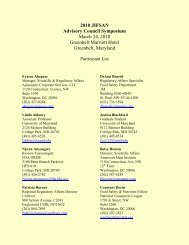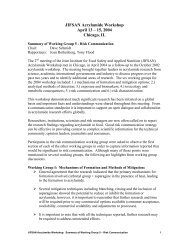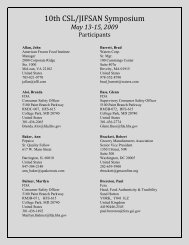Download PDF - jifsan
Download PDF - jifsan
Download PDF - jifsan
- No tags were found...
Create successful ePaper yourself
Turn your PDF publications into a flip-book with our unique Google optimized e-Paper software.
A Core Statute for Food IngredientSafety: Sec. 409 of the FD&C Act• Defines “food additive” (w/ GRAS exemption)• Requires premarket approval of new uses offood additives, if not “GRAS”• Establishes the standard of data review• Establishes the standard of safety• Establishes formal rulemaking procedures forpetition review• ------------since FDAMA of 1997:------------------• Defines “food contact substance” (FCS)• Establishes a premarket notification programfor food contact substances
Standard of Review“Fair evaluation of the data . . .”
House of Representatives, Report No. 2284, “FoodAdditives Amendment of 1958”Committee on Interstate & Foreign Commerce, 85thCongress, 2nd Session, July 28, 1958“The committee feels that the Secretary’sfindings of fact and orders should not be basedon isolated evidence in the record, whichevidence in and of itself may be consideredsubstantial without taking account of thecontradictory evidence of equal or even greatersubstance . . . .”
Safety Standard“Reasonable certainty of no harm . . .”
REASONABLE CERTAINTY OF NO HARMLegislative History of the FD&C ActThe concept of safety used in this legislationinvolves the question of whether a substance ishazardous to the health of man or animal.Safety requires proof of a reasonable certaintythat no harm will result from the proposed useof an additive.It does not -- and cannot -- require proofbeyond any possible doubt that no harm willresult under any conceivable circumstance.H.R. Report No. 2284, 85th Congress 1958
The RCNH Standard of Safetyfor Food AdditivesThe petitioner has the burden todemonstrate a “reasonable certainty ofno harm” from the intended use of theadditiveThis requires that the FDA assess whetherit has received from the petitioneradequately documented answers toappropriate questions of probative value.
Reasonable Certainty ofNo HarmWhat does“Reasonable Certainty of No Harm”mean?
Reasonable Certainty ofNo HarmIt is not intended to ensure, nor is itpossible to ensure, safety withabsolute certainty:i.e., “Reasonable Certainty of NoHarm” is not “Certainty of NoTheoretical Possibility of Harm.”
Traditional Safety Evaluation(Petitions)• A “full blown,” exhaustive safety evaluationof all appropriate data, information andstudies, with agency “ownership” of theultimate safety decision and publication ofits decision and supporting rationale in theFederal Register.
Toxicological TestingThe CFSAN “Redbook”Minimum Toxicity TestsShort-term tests for genetic toxicityMetabolism & pharmacokineticstudiesShort-term tox tests with rodentsSubchronic tox tests with rodentsSubchronic tox tests with nonrodentsReproduction study w/ teratologyphaseOne-Yr tox tests with non-rodentsCarcinogenicity study with rodentsChronic tox/ carcinogenicity studywith rodentsConcern LevelsI II IIIX X XXX XX XXX XXXX
The “Toxicological” Safety Assessment Model(Based on the Review of Toxicological Data)• Requires defining population exposureto the additive, “Estimated DailyIntake” (or EDI), and• Comparing that to an “AcceptableDaily Intake” (ADI) from toxicologicalstudies
The “Toxicological” Safety Assessment Model(Based on the Review of Toxicological Data)• Lifetime-average, “high eaters only” EDI• HNEL from lifetime animal studies• Threshold behavior for toxic effects• Application of appropriate safety(uncertainty) factors (e.g., 10x and 10x)• Acceptable Daily Intake or ADI• Comparison of the EDI to the ADI• No effects at estimated consumption levels
The “Circle” ofReasonable Certainty of No HarmAs a metaphor for the process,think of the goal as: “being within a circle of unit radius”as defined below:“Safe” within the meaningof the FD&C ActEDI/ADI
Beyond the TraditionalToxicology FrameworkThe Case of the Food AdditiveOLESTRA
“Olestra”a macronutrient substitute for fat• Under the FD&C Act, olestra was a new foodadditive use…• 1987 Petition from P&G for olestra use as a fatsubstitute (later only for use in “savory snacks”)• …requiring FDA premarket safety evaluation.• This, in turn, required the review of data on likelyhuman exposure, toxicological properties and, as itturns out, effects on human physiology andnutrition, as well.
Olestra…What is it?• Olestra is a Sucrose Polyester, a mixtureof substances formed by chemicalcombination of sucrose with 6, 7, or 8 fattyacids.• It has many of the physical properties ofnatural fats, and therefore cantechnologically substitute for fat in foodmanufacture.
Olestra: Molecular Structure
6,7 or 8C 12 -C 20 fatty acidsesterified to the twosucrose rings
Beyond “Toxicity” Studies• For some food ingredients / additives, includingolestra, the traditional portfolio of “toxicity” studiesis of limited value in defining the entire safetypicture because it does not produce acomprehensive view of additive safety underconditions of use.• When that is the case, then other informationmust be sought and evaluated:
Beyond “Toxicity” Studies• For olestra there was not an “ADI,” as such…But…• There was the likelihood of be significant“nutritional effects”• As well as significant “physiological effects”
Beyond “Toxicity” StudiesIn fact….• Clinical data may become as important as“toxicological” data• Chemical Identity / SAR may be of value• “ADME” studies may be more important• Human “Tolerance” studies can play a role• Clinical studies of various types may be needed• Post-market monitoring (both passive andactive surveillance) may be justified as well
Summary of Olestra Data Review• So, let’s review olestra’s overall data picture:• Chemical identity and probable consumption• A portfolio of “traditional” toxicity studies in arange of species• Nutritional Impact Studies (swine and humans)• GI effects, physiological responses from clinicalstudies• FDA’s Decision Process
Summary of Olestra Data Review• Identity and Use• Manufacturing Process• Constituents• Specifications• Stability• Estimated Daily Intake; “probable consumption”
Summary of Olestra Data ReviewToxicity Testing Data• Toxicity Data• ADME (rat, guinea pig, mini-pig)• Teratology studies• Sub-Chronic Feeding Studies (rats, 90 d)• Chronic / Carcinogenicity Feeding Studies in rats andmice; dog feeding studiesNo adverse effects seen upon which to determinean ADI in the traditional sense.
Summary of Olestra Data ReviewDrug Interference Data• Effect of Olestra on Absorption of Drugs (?)• Selected Lipophilic Drugs• Range of lipophilicity from aspirin to ethinylestradiol• Effect of olestra on drug bioavailability• Effect on systemic levels of steroidalhormones in women taking oral contraceptives
Summary of Olestra Data ReviewNutritional Studies• Nutritional Studies (in both animals / humans)• Hypothesis; olestra interferes with the absorptionof fat-soluble nutrients when those nutrientspartition into olestra in the GI tract.• Both fat-soluble and water soluble nutrientsstudied• Folate, Vitamin B 12 , calcium, zinc, and iron• Vitamins A, D, E, K• Studies (DR, VR) conducted in both humans andpigs
Studies to Assess Nutritional Effectsof Olestra ConsumptionHuman StudiesPig Studies• 8-Wk clinical DR• 8-Wk clinical VR• 6-Wk V D/K status• 16-Wk V E status• 14-d V A/fat absorption• 26-Wk DR & VR• 39-Wk VR• 12-Wk DR• 12-Wk VR• 4-Wk “dietary context”
Summary of Olestra Data ReviewHuman Clinical Studies• Primary reliance on two 8-week clinicalstudies on dose-response and vitaminrestoration:• Complete control of nutrient intake• Double-blind placebo-controlled• Olestra added to food vs. triglyceride; 0, 8, 20,32 g/d• Diets 15% cal from protein; 55% from carbs;and still 30% from triglycerides• GI symptoms recorded if experienced
Summary of Olestra Data Review8-Wk Clinical Dose-Response Study• Serum levels of A,D,E,K, folate, B 12 , andZinc measured• Decreases in serum levels of fat sol.Vitamins seen (serum retinol only for A)
Summary of Olestra Data Review8-Wk Clin. Vitamin Restoration Study• Determined levels of vitamins A,D,E, andK to add back to food to compensate forany losses due to olestra
Summary of Olestra Data ReviewStudies in Swine• Five nutritional studies of varying lengths(12, 12, 26, 39, and 4 Wks).• Helped determine DR; and Vitaminrestoration levels appropriate to avoid anylowering of serum levels (or liver stores ofVitamin A)
Nutrient Status Measurementsin 12-Week Pig DR StudyVitamin A……….Vitamin E……….Vitamin D……….Vitamin K……….Folate……………Vitamin B 12…….Calcium…………Phosphorous….Iron………………Zinc………………NutrientMeasurementsLiver & Serum conc.Liver, Serum, Adipose tissue conc.Serum Conc of different formsProthrombin timePlasma concentrationLiver concentrationBone, serum Ca, bone ash conc.Bone and serum concentrationLiver iron and serum concs.Liver, bone, serum concentrations
Carotenoids• Serum levels are affected• Much discussion from all sides (the petitioner,many comments, special FDA consultants, foodadvisory committee, NCI, and NEI experts)• FDA concluded that effects of olestra onabsorption of lipophilic carotenoids, “reasonablycertain to be insignificant from a public healthstandpoint.”
GI EffectsIssues that were of potential concern to FDA:1. Potential for loose stools or diarrhea to resultin electrolyte and fluid loss2. Interference with normal daily life3. Special concerns for subpopulations(children, GI compromised, the elderly)4. Microfloral changes in the gut
GI Effects• After review by FDA of submitted studies,and the FDA Food Advisory Committee,including gastroenterologists, etc., FDAconcluded:• Reasonable certainty of no harm w.r.t.potential for olestra to cause GI effects• Could cause loose stools, but not adversebecause do not threaten health.
Some Conclusions from theOlestra Data Review• Conclusions from Nutritional Studies:• Olestra affects the status of fat sol. vitamins• Potential losses can be compensated for• Compensation levels determinedquantitatively• Conclusions on GI Effects:• There are effects, but they do not adverselyaffect health
FDA’s s Safety Review: Summary• Standard regimen of toxicological studies• Supplemented by a range of special studies(nutritional impact studies, e.g., in swine andother species, including human clinical studies) toelicit information about the nutritionalcharacteristics and impact of the material on thosewho ingest it.• Consultations 1/1 with and a roster of notedexperts on animal and human nutrition,physiology, medicine, etc., B. Schneeman, then ofU. Cal. Davis, as primary consultant.
FDA’s s Safety Review: Summary• Separate consults w/ NCI (Dr. Greenwald) re:carotenoids, and NEI (Dr. Kupfer) re: no maculardegeneration potential• Assembling of FDA’s Food Advisory Committee(4 days in November 1995)• Special Labeling required (to preclude productmisbranding in the marketplace; interimrequirement)• Use of passive and active post market surveillance• Final regulation published FR January 30, 1996• Second FAC June 1998• Labeling requirement rescinded, FR August 2003
Labeling of FoodsContaining Olestra• Olestra-containing foods were originallyrequired to carry the following labelstatement:This Product Contains Olestra. Olestra maycause abdominal cramping and loose stools. Olestrainhibits the absorption of some vitamins and othernutrients. Vitamins A, D, E, and K have been added.
Overall FDA Conclusions• Olestra is not toxic, carcinogenic, genotoxic, or teratogenic.• It is essentially not absorbed or metabolized.• It has an effect on the absorption of vitamins A, D, E, and K.• It is possible to supplement foods containing olestra with all fourvitamins so as to compensate for amounts not absorbed from the dietdue to the action of olestra.• No harmful effects on water soluble vitamins / minerals, includingvitamin D mediated calcium uptake.• Carotenoids need not be compensated for.• GI effects seen do not represent significant adverse healthconsequences.• FDA did initially require a label statement, active and passivepostmarket monitoring, and a follow-up Food Advisory Committeewithin 30 months of approval.• Other, later studies (home use study; n=3000) show little problem
A More Complex “Circle” ofReasonable Certainty of No HarmHumanTolerance(physiologicaleffects; GI)Nutritional Effects(Nutrient Depletionand Restoration)Our metaphorical circle of RCNHhas become more complicated!Identity & Exposure(Dose Response)EDI/ADI?Drug InterferenceEffectsPostmarketMonitoringRequirements
Beyond the “Tox” Framework:(other areas where ADI concept alone may not be feasible)• Macro Ingredient Substitutes• lipids• carbohydrates• proteins• Enzymes used in food processing• Fiber sources• Complex mixtures• Irradiated food• Herbals and other “bioactive” ingredients inconventional foods and supplements
“Generally Recognized as Safe”(GRAS)Food Ingredients
FFDCA Definition of“food additive”“Component” partof the definition201(s): “…any substance, the intended use ofwhich results or may be expected to result,directly or indirectly, in its becoming acomponent or otherwise affecting thecharacteristics of any food…The “GRAS Exemption”if such substance is not generally recognized,among experts qualified by scientific trainingand experience…to be safe under theconditions of its intended use”
GRAS Criteria: Comparing a GRASSubstance to a Food AdditiveFood AdditiveGRAS SubstanceFDA“TechnicalElement”“CommonKnowledgeElement”“TechnicalElement”GenerallyavailableGenerallyaccepted
GRAS Notification Procedurebased on the April 1997 FR Proposal• Voluntary• Notifier informs FDA of notifier’s viewthat a use of a substance is GRAS• FDA responds by letter
3 Types of Responseto a GRAS Notice• FDA has “no questions”• Notice “does not provide a basis” for aGRAS determination• At notifier’s request, FDA ceased toevaluate the notice• Letters available on the Internet athttp://www.cfsan.fda.gov/~rdb/opa-gras.html
Other Examples of “Bioactive”Food Ingredients?• Other macroingredient substitutes (for lipids,carbohydrates, proteins)• Phytostanol Esters and Vegetable Oil SterolEsters in spreads (e.g., Benecol TM and TakeControl TM )• Range of materials in GRAS Notices (enzymes,fiber sources, herbs in conventional food)• Infant Formula Ingredients (e.g., novel sources ofDHA and ARA (LCPUFAs) as IF ingredients)
Other Examples of “Bioactive”Food Ingredients in GRAS NoticesExamples where FDA Had “No Questions”:• Vegetable oil sterol esters (Take Control TM )• Phytostanol esters (Benecol TM )• Lactoferrin (GRN 77)• Fructooligosaccharides (GRN 44)• Small planktivorous pelagic body fish oil (GRN 102)• Fish oil concentrate (GRN 105)• Tuna oil (GRN 109)• Diacylglycerol oil (GRNs 56 and 115)• Inulin (GRN 118)
Other Examples of “Bioactive”Food Ingredients in GRAS NoticesExamples where FDA “Questions” thenotifier’s GRAS notice:• 6 Chinese Herbs (GRN 13)• Garcinia cola (GRN 25)• Crospovidone-cranberry extract (GRN 30)• Hempseed oil (GRN 35)• Milk thistle extract (GRN 66)• Grape Seed Extract and Grape Skin Extract(GRN 93)
Nutritional Risk Assessment?• For Nutrients added to food, or possibly• For other Bioactive ingredients in food• When we may expect nutrition relatedeffects aside from any potentialtoxicological responses
Nutritional Risk AssessmentRequires:• Expanded understanding of the exposure scenario of thepopulation and/or subgroups to substances of nutritionalinterest or bioactive capacity in foods.• The context of such exposure scenarios in comparisonto all other substances important to the diet.• An understanding of the relevant dose/responserelationships, both beneficial and detrimental forsubstances in the diet. (For nutrients or other bioactiveingredients, this may include knowledge of both thebenefits of exposure to adequate levels, as well as risksassociated with ingesting too much, and the relevantbiochemical mechanisms of both.)
Nutritional Risk Assessment• An understanding of the inherent and methodologicalerrors and uncertainties associated with those doseresponserelationships.• Understanding of the interactions among nutrients orother bioactive ingredients, and other components of thediet that influence nutrient bioavailability or additivesafety• Impact of novel foods and food components on overalldietary patterns• Physiological responses to the presence of thesubstance in the diet, such as gastrointestinalintolerance, etc.
Nutritional Risk Assessment• Data from animal models (both dose response andmechanistic information) as well as human clinical data• Need for application of various types of quantitative andstatistical modeling techniques, including Monte Carlomodels for premarket and active and passivepostmarket monitoring and analyses• Other sources of relevant information on safety from thenew fields of genomics, metabolomics, proteomics, andnow, “nutrigenomics,” etc.
A Still More Complex “Circle” ofReasonable Certainty of No HarmHumanTolerance(physiologicaleffects; GI effects)Nutritional Effects(Nutrient Depletion andRestoration; gut microflora;metabolism effects, etc. )Identity & Exposure(Dose Response; Similarity toFood and normal bodily constituents)EDI/ADI(?)Allergenicity (FALCPA)Drug InterferenceEffectsPostmarketMonitoringActive/Passive
Relative Food-Related Concerns(A Popular View)• Added Food Chemicals• Environmental Contaminants in Food• Food Hazards of Natural Origin• Microbial Contamination of Food• Nutritional Hazards
Relative Food-Related Concerns(A Possibly More Accurate View)• Nutritional Hazards• Microbial Contamination of Food• Food Hazards of Natural Origin• Environmental Contaminants in Food• Added Food Chemicals
Nutritional Safety Assessmentties the top and bottom together!• Nutritional Hazards• Microbial Contamination of Food• Food Hazards of Natural Origin• Environmental Contaminants inFood• Added Food Chemicals
The End!Thank You!





